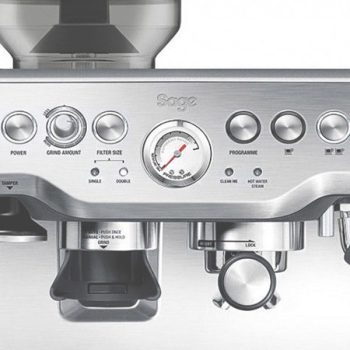
The Basics: Extracting and operating
The romantic idea of getting up of a weekend, reading a paper and making a cappuccino is appealing to most if not all home coffee enthusiasts. There’s something pleasantly ritualistic about the whole thing. However owning, operating and cleaning an espresso machine is not only an investment in good quality equipment, it’s also an investment in time. If you’re lucky enough to own one, you’ve undoubtably researched the machine at length and aware of what it is you’ve actually purchased.
Whether or not this is the case, I’d still strongly recommend reading our previous article “Best coffees for a Sage Machine”. It covers the product basics and contains our favourite coffee recommendations.
This article will cover the operational basics of the Sage Barista Express and the Barista Pro models. On the whole, they’re largely similar, extracting and steaming in the exact same way. The main differences being the Pro has a digital display as opposed to the analog display of the Express. The built in grinder on the Pro has 30 micro-adjustment settings compared to the Express’ 18. Both are extremely user friendly and are Espresso machines that offer you lots of control over each drink you make.
Extraction Basics – Making the perfect espresso with Sage
Before you begin: Note that the time to get the machine and equipment up to temperature is approximately 15 minutes.
The boiler heats up in 30 seconds (3 seconds on the Pro version thanks to the new Thermo Jet technology) but you have to allow the head and group handle to reach temperature as well.
However if you just can’t wait to get started, attach the group handle to the head and run a couple of blank shots through it. This should heat it up sufficiently in a fraction of the time.
So what does a good Espresso look like?
You’re looking for something we call ‘the mouse’s tail’ The coffee should pour evenly from each side of the handle, dipping in towards the centre as it pours.
If the stream of coffee appears to twist and is pale in colour — your grind it too coarse and the Espresso will be under extracted. On the other hand if the coffee drips, is dark in colour and never reaches a steady flow — your grind is too fine and will result in over-extraction.
This is why it’s best practice to pull a shot and see how it pours before you do anything else.
As the grinder is so sensitive, when you change it do so in small amounts and grind off a shot after you make an adjustment, this purges any of the old grounds out of the grinder.
This process may have to be repeated a few times, and although it may seem lengthy, you’ll achieve the perfect Espresso. The foundation on which to build your Barista-style drinks.
Drink Basics using a Sage Barista Machine
How to steam the milk with a Sage
Now you have the perfect Espresso it’s time to turn your attention to steaming the milk. Before steaming, push the wand down towards the grid and it will automatically purge out any condensation, (a simple but thoughtful use of technology that has great benefit to the user).
This should also be repeated after you’re finished steaming, missing this step risks the milk syphoning back up into the boiler of the machine.
Be sure to wipe down the arm with a damp cloth after every use to remove any left over milk residue. You’ll be surprised at how quickly this builds up and once it does, becomes a pain to remove.
So, just how do you steam the milk for your coffee shop favourite? We’ll admit, steaming milk requires a bit of know-how and a fair bit of practice. Steaming, frothing or emulsifying the milk is achieved in two different stages:
- Aerating (stretching) the milk is the process of introducing air into it. This increases the volume of the milk and creates the microfoam
- The second stage is texturing- this combines the microfoam you have built and creates an even texture.
How to Make Latte with a Sage
- Fill the milk to just under the spout
- Place the nozzle into the centre of the jug at a 45 degree angle, it should sit just below the surface of the milk.
- Stretch the milk for 4 to 5 seconds. Lower the jug as the milk expands to keep it in the same position.
- Aim for a 30 – 35% increase in volume.
- Once the volume has increased, raise the jug to bury the nozzle. This creates a spinning vortex that combines the foam.
- Turn off the steam before removing the wand from the jug at 150 Fahrenheit
- Tap and swirl the pitcher to finish combining the microfoam
- The texture should be similar to that of wet paint or melted ice cream
- Slowly pour the steamed milk over your espresso
How to make Cappuccino with a Sage
- Fill the milk to about 2cm below the spout
- Place the nozzle in the centre of the jug, keeping the jug flat
- Make sure the nozzle is just under the surface of the milk and stretch until the milk has doubled in volume
- Bury the nozzle and finish steaming until the milk is up to temperature (150 Fahrenheit)
- Set the pitcher on the side and tap and swirl, more so than you would for latte as you have more microfoam to combine.
- Hold the jug at a 45 degree angle and low to the surface of the espresso. Use your wrist to flick the milk into the cup, this makes sure you get the foam into the cup instead of pouring through it.
- Tip: Pour out of the side of the jug instead of the spout
How to make Flat White with a Sage
There’s no better way to make a flat white than with a barista machine.
Here’s how to do it:
- Fill the milk to about 2cm below the spout
- Place the nozzle 1cm under the surface of the milk and 1cm from the edge of the jug
- Keep the jug flat and steam for 3 – 4 seconds
- The volume should increase by about 20%
- For the remainder of the process angle the jug to create a vortex. Switch off at 150 Fahrenheit.
- Set the pitcher on the side and leave it to rest for a few seconds, then gently wiggle the jug. The milk should have the same sheen and thickness as double cream.
- Pour low and slow, starting in the centre of the cup. Start to go round in circles until the cup is two-thirds full — being careful not to break the crema.
- At this point concentrate the pour in the centre of the cup and angle the jug more, you should see the milk start to come through to the surface.
* At this point you can start to experiment with how to pour latte art. Pour slowly, keeping the movement in your wrist (your elbow should be still) Remember to have fun and yes… practice makes perfect!

